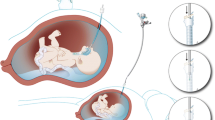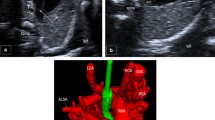Abstract
Background
Fetuses with severe congenital diaphragmatic hernia (CDH) and pulmonary hypoplasia may benefit from fetal endoluminal tracheal occlusion (FETO). Enlargement of the main bronchi and trachea appears to be a common complication of FETO.
Objective
To retrospectively evaluate the trachea and main bronchi of infants who underwent FETO for CDH and compare diameters with age-matched references.
Material and methods
Postnatal and follow-up chest radiographs were performed in seven children with unilateral CDH treated by FETO. Additional CT was performed in six of these (one neonate died before CT could be performed). Images were acquired from 3 days to 23 months of age. For each child, radiographs and CT images with optimal visualisation of the airways were selected for retrospective analysis. Tracheal and bronchial morphology was assessed by two experienced paediatric radiologists, and the diameters of these structures measured and compared with age-matched references.
Results
Mean diameters of the trachea and main bronchi were above the age-matched normal range in all patients, regardless of the side of the hernia or the degree of lung hypoplasia.
Conclusion
Enlargement of the trachea and main bronchi appears following FETO and persists at least to the age of 5 years.






Similar content being viewed by others
References
Lally KP (2002) Congenital diaphragmatic hernia. Curr Opin Pediatr 14:486–490
Seaward GR (2005) The fetal chest. In: Rumack CM, Wilson SR, Charboneau JW (eds) Diagnostic ultrasound, 3rd edn. Elsevier Mosby, St. Louis, pp 1303–1321
Paek BW, Coakley FV, Lu Y et al (2001) Congenital diaphragmatic hernia: prenatal evaluation with MR lung volumetry preliminary experience. Radiology 220:63–67
Büsing KA, Kilian K, Schaible T et al (2008) MR relative fetal lung volume in congenital diaphragmatic hernia: survival and need for extracorporeal membrane oxygenation. Radiology 248:240–246
Laudy JA, Van Gucht M, Van Dooren MF et al (2003) Congenital diaphragmatic hernia: an evaluation of the prognostic value of the lung-to-head ratio and other prenatal parameters. Prenat Diagn 23:634–639
Taylor GA, Atalabi OM, Estroff JA (2008) Imaging of congenital diaphragmatic hernias. Pediatr Radiol 39:1–16
Jani J, Cannie M, Sonigo P et al (2008) Value of prenatal magnetic resonance imaging in the prediction of postnatal outcome in fetuses with diaphrag matic hernia. Ultrasound Obstet Gynecol 32:793–799
Cannie M, Jani J, Meersschaert J et al (2008) Prenatal prediction of survival in isolated diaphragmatic hernia using observed to expected total fetal lung volume determined by magnetic resonance imaging based on either gestational age or fetal body volume. Ultrasound Obstet Gynecol 32:633–639
Fuke S, Kanzaki T, Mu J et al (2003) Antenatal prediction of pulmonary hypoplasia by acceleration time/ejection time ratio of fetal pulmonary arteries by Doppler blood flow velocimetry. Am J Obstet Gynecol 188:228–233
Doné E, Gucciardo L, Van Mieghem T et al (2008) Prenatal diagnosis, prediction of outcome and in utero therapy of isolated congenital diaphragmatic hernia. Prenat Diagn 28:581–591
Jani J, Nicolaides KH, Benachi A et al (2008) Timing of lung size assessment in the prediction of survival in fetuses with diaphragmatic hernia. Ultrasound Obstet Gynecol 31:37–40
Jani J, Nicolaides KH, Keller RL et al (2007) Observed to expected lung area to head circumference ratio in the prediction of survival in the fetuses with isolated diaphragmatic hernia. Ultrasound Obstet Gynecol 30:67–71
Dillon E, Renwick M, Wright C (2000) Congenital diaphragmatic hernia: antenatal detection and outcome. Br J Radiol 73:360–365
Stege G, Fenton A, Jaffray B (2003) Nihilism in the 1990s: the true mortality of congenital diaphragmatic hernia. Pediatrics 112:532–535
Deprest J, Jani J, Gratacos E et al (2005) Fetal intervention for congenital diaphragmatic hernia: the European experience. Semin Perinatol 29:94–103
Deprest J, Gratacos E, Nicolaides KH et al (2004) Fetoscopic tracheal occlusion (FETO) for severe congenital diaphragmatic hernia: evolution of a technique and preliminary results. Ultrasound Obstet Gynecol 24:121–126
Breysem L, Debeer A, Claus F et al (2010) Cross-sectional study of tracheomegaly in children after fetal tracheal occlusion for severe congenital diaphragmatic hernia. Radiology 257:226–232
McHugh K, Afaq A, Broderick N et al (2009) Tracheomegaly: a complication of fetal endoscopic tracheal occlusion in the treatment of congenital diaphragmatic hernia. Pediatr Radiol 40:674–680
Speggiorin S, Fierens A, McHugh K et al (2011) Bronchomegaly as a complication of fetal endoscopic tracheal occlusion. A caution and a possible solution. J Pediatr Surg 46:e1–e3
Courtier J, Poder L, Wang ZJ et al (2010) Fetal tracheolaryngeal airway obstruction: prenatal evaluation by sonography and MRI. Pediatr Radiol 40:1800–1805
Griscom NT, Wohl ME (1986) Dimensions of the growing trachea related to age and gender. AJR 146:233–237
Altman PL, Dittmer DS (1971) Respiration and circulation (Biological Handbooks). Federation of American Societies for Experimental Biology, Bethesda, pp 105–108
Hubbard AM, Crombleholme TM (1998) Anomalies and malformations affecting the fetal/neonatal chest. Semin Roentgenol 33:117–125
Guimaraes CV, Linam LE, Kline-Fath BM et al (2009) Prenatal MRI findings of fetuses with congenital high airway obstruction sequence. Korean J Radiol 10:129–134
Lim FY, Crombleholme TM, Hedrick HL et al (2003) Congenital high airway obstruction syndrome: natural history and management. J Pediatr Surg 38:940–945
Mong A, Johnson AM, Kramer SS et al (2008) Congenital high airway obstruction syndrome: MR/US findings, effect on management, and outcome. Pediatr Radiol 38:1171–1179
Grethel EJ, Nobuhara KK (2006) Fetal surgery for congenital diaphragmatic hernia. J Paediatr Child Health 42:79–85
Harrison MR, Keller RL, Hawgood SB et al (2003) A randomized trial of fetal endoscopic tracheal occlusion for severe fetalcongenital diaphragmatic hernia. N Eng J Med 349:1916–1924
Moore KL, Persaud TVN (2002) The developing human: clinically oriented embryology, 7th edn. Saunders, Philadelphia
Biyyam DR, Chapman T, Ferguson MR et al (2010) Continuing medical education: congenital lung abnormalities: embryologic features, prenatal diagnosis, and postnatal radiologic-pathologic correlation. Radiographics 30:1721–1738
Jani J, Valencia C, Cannie M et al (2011) Tracheal diameter at birth in severe congenital diaphragmatic hernia treated by fetal endoscopic tracheal occlusion. Prenat Diagn 31:699–704
Acknowledgments
We thank Ms. Christine O’Hara for invaluable help with preparing the manuscript.
Author information
Authors and Affiliations
Corresponding author
Rights and permissions
About this article
Cite this article
Enriquez, G., Cadavid, L., Garcés-Iñigo, E. et al. Tracheobronchomegaly following intrauterine tracheal occlusion for congenital diaphragmatic hernia. Pediatr Radiol 42, 916–922 (2012). https://doi.org/10.1007/s00247-012-2362-x
Received:
Revised:
Accepted:
Published:
Issue Date:
DOI: https://doi.org/10.1007/s00247-012-2362-x




